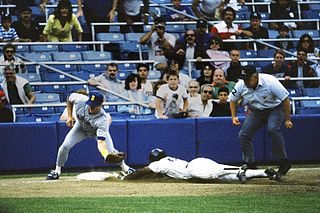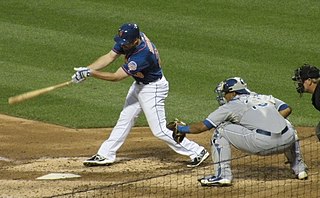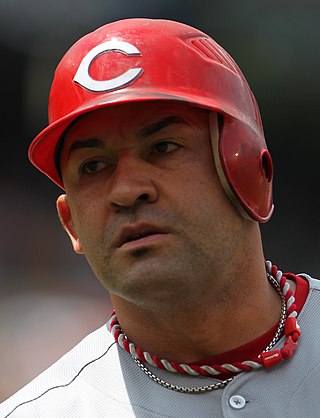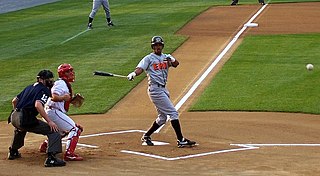
In baseball, hit by pitch (HBP) is an event in which a batter or his clothing or equipment is struck directly by a pitch from the pitcher; the batter is called a hit batsman (HB). A hit batsman is awarded first base, provided that he made an honest effort to avoid the pitch, although failure to do so is rarely called by an umpire. Being hit by a pitch is often caused by a batter standing too close to, or "crowding", home plate.

In baseball, a stolen base occurs when a runner advances to a base unaided by other actions and the official scorer rules that the advance should be credited to the action of the runner. The umpires determine whether the runner is safe or out at the next base, but the official scorer rules on the question of credit or blame for the advance under Rule 10 of the MLB's Official Rules.

Softball is a popular variation of baseball, the difference being that it is played with a larger ball, on a smaller field, and with only underhand pitches permitted. Softball is played competitively at club levels, the college level, and the professional level. The game was first created in 1887 in Chicago by George Hancock.

In baseball, the pitcher is the player who throws ("pitches") the baseball from the pitcher's mound toward the catcher to begin each play, with the goal of retiring a batter, who attempts to either make contact with the pitched ball or draw a walk. In the numbering system used to record defensive plays, the pitcher is assigned the number 1. The pitcher is often considered the most important player on the defensive side of the game, and as such is situated at the right end of the defensive spectrum. There are many different types of pitchers, such as the starting pitcher, relief pitcher, middle reliever, lefty specialist, setup man, and the closer.

Catcher is a position in baseball and softball. When a batter takes their turn to hit, the catcher crouches behind home plate, in front of the (home) umpire, and receives the ball from the pitcher. In addition to this primary duty, the catcher is also called upon to master many other skills in order to field the position well. The role of the catcher is similar to that of the wicket-keeper in cricket.

In baseball, the pitch is the act of throwing the baseball toward home plate to start a play. The term comes from the Knickerbocker Rules. Originally, the ball had to be thrown underhand, much like "pitching in horseshoes". Overhand pitching was not allowed in baseball until 1884.

A batting helmet is worn by batters in the game of baseball or softball. It is meant to protect the batter's head from errant pitches thrown by the pitcher. A batter who is "hit by pitch," due to an inadvertent wild pitch or by intent, may be seriously, even fatally, injured.

In baseball, an intentional base on balls, usually referred to as an intentional walk and denoted in baseball scorekeeping by IBB, is a walk issued to a batter by a pitcher with the intent of removing the batter's opportunity to swing at the pitched ball. A pitch that is intentionally thrown far outside the strike zone for this purpose is referred to as an intentional ball.

In baseball, a foul ball is a batted ball that:
Chin music is a slang term with several different meanings.

Throughout baseball's history, the rules have frequently changed as the game continues to evolve. A few typical rules most professional leagues have in common are that four balls are a base on balls, three strikes are a strikeout, and three outs end a half-inning.

In baseball, a brushback pitch is a pitch thrown high and inside the strike zone to intimidate the batter away from the plate on subsequent pitches. It differs from the beanball in that the intent is not to hit the batter, nor does it target the batter's head. Hitters will often crowd the plate in order to have a better swing at pitches on the outside half of the plate. The hitters hope that the pitcher will be scared to throw inside because they might hit the batter. The brushback helps a pitcher to "reclaim" the corners of the strike zone by forcing the batter to stand further away.
Baseball and cricket are the best-known members of a family of related bat-and-ball games. Both have fields that are 400 feet (120 m) or more in diameter between their furthest endpoints, offensive players who can hit a thrown/"bowled" ball out of the field and run between safe areas to score runs (points) at the risk of being gotten out, and have a major game format lasting about 3 hours.
In baseball, interference occurs in situations in which a person illegally changes the course of play from what is expected. Interference might be committed by players on the offense, players not currently in the game, catchers, umpires, or spectators. Each type of interference is covered differently by the rules.

In baseball, a pitcher may commit illegal motions or actions that constitute a balk. Most of these violations involve pitchers pretending to pitch when they have no intention of doing so. In games played under the Official Baseball Rules that govern professional play in the United States and Canada, a balk results in a dead ball or delayed dead ball. In certain other circumstances, a balk may be wholly or partially disregarded. In the United States, under the National Federation of State High School Associations, a balk results in an immediate dead ball. In the event a balk is enforced, the pitch is generally nullified, each runner is awarded one base, and the batter (generally) remains at bat with the previous count. The balk rule in Major League Baseball was introduced in 1898.

Pesäpallo is a fast-moving bat-and-ball sport that is often referred to as the national sport of Finland and has some presence in other places including Germany, Sweden, Switzerland, Australia, and Canada's northern Ontario. It is similar to brännboll, rounders, lapta, and baseball.

Mario Melvin Soto is a Dominican former pitcher, mostly as a starter, for the Cincinnati Reds of Major League Baseball (MLB) from 1977 through 1988. He currently works in the Reds' front office.

Ronald Clarence Kulpa is an American umpire in Major League Baseball. He wears uniform number 46.
This is an alphabetical list of selected unofficial and specialized terms, phrases, and other jargon used in baseball, along with their definitions, including illustrative examples for many entries.

There is a set of unwritten rules of baseball that some players and managers follow. The rules often concern gamesmanship and not disrespecting players on the opposing team. Incidents have occurred when one or more players interpret the actions of another player as violating the unwritten rules, which can result in beanballs and bench-clearing brawls. As the rules are unwritten, and in many cases vague, the interpretation is left to the players involved.

















